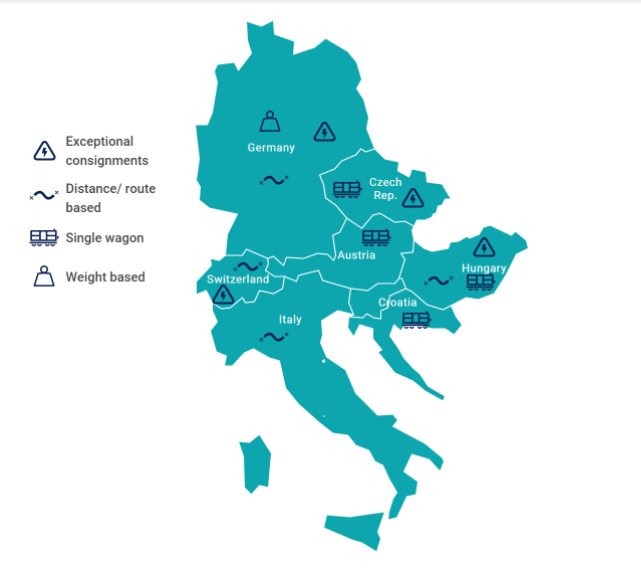How Latvia segments the railway market for infrastructure charging

There are different ways in which countries determine segments on the rail market for infrastructure charging. In a webinar on 17 March, an online seminar on railway transportation market segmentation was held by LatRailNet, the Latvian charging body. It was also presented how it deals with changing market conditions and how discounts can be applied to stimulate using the rail infrastructure to its full capacity.
Market segmentation, in compliance with the requirements of European Union and Latvian national laws and regulations, is performed in passenger and freight transportation in order to set railway infrastructure charges that are appropriate to the market situation and to promote development of domestic and international transportation markets.
Currently in Latvia, there are 12 market segments – four in passenger and eight in freight transportation. For example, there is a different market segment for use of broad and narrow-gauge parts of the network. In freight, there are different market segments for domestic and international transport, and container or other types of transport, for example. Regularity of freight transport also plays a role.
The list of market segments is reviewed every 5 years and it is supervised by the railway sector regulatory body. In the recent webinar by LatRailNet, the legal framework of railway transportation market segmentation, the segmentation process and the main evaluation criteria were presented. The application and processing procedure was also explained. More than 60 transport industry professionals and other interested parties attended.
What is market segmentation based on?
International practice demonstrates that EU member states, besides compulsory segmentation to freight, commercial passengers and passengers under Public Service Obligation (PSO) transportation, mostly perform segmentation based on the transportation distance (suburban, regional and international transportation), environmental hazard of the freight, transportation technology (route or mixed transportation), train weight, and only sometimes as market-based incentives. In Latvia, it is a combination of methods.
Article continues below image

“Market segmentation provides the railway sector with a wide range of opportunities for boosting its competitiveness. In addition, the chosen segmentation approach plays an important role in achieving market development, environment protection and accident reduction objectives set out in the national planning documents”, points out the seminar leader and LatRailNet CEO Justina Hudenko.
Three-step approach
In the webinar, Hudenko presented Latvia’s three-step market segmentation approach. Step one performs after mandatory extraction of direct costs from total costs of the minimum access package. This, according to the EU Railway Legislation, is the basis for the track access charge. This step allows to adjust extracted minimum charges that reflects maintenance and operational costs driven by track usage to railway undertaking’s benefits. The first segmentation step requires big market assessment expertise (and respective costs) and is performed once every five years.
Applicants require specific conditions for utilisation of the infrastructure that allow them to adapt to the final customers’ preferences (such as running heavier than average train, or at congested departure or arrival times). It also allows to adapt to any own technological failures, which causes the infrastructure manager additional costs which would otherwise be avoided and cannot be included in the infrastructure charge.
The infrastructure manager’s services improve the criteria of final customers’ preferences compared to competing modes of transport and infrastructure networks. For example, when specific departure or arrival times within combined transportation increase train operating costs, decrease capacity usage, but allow higher income level of railway undertakings.
Changing market conditions
In order to adapt the track access charges level to changing market conditions, a second step was incorporated in the TAC scheme. This way, applicants can provide the evidence that, within the existing or the foreseen market conditions, the criteria and their values calculated in step 1 are not equivalent for different types of use of the railway infrastructure. Another example is that the market cannot bear the existing infrastructure charge, or there are particular market segments which railway undertakings are not currently operating but may provide services in.
In the third step, the charging body can apply charge differentiation tools to a market segment. The first is a scarcity charge, which reflects the scarcity of the infrastructure capacity in a specified part of the railway infrastructure during congestion periods. There is also the environmental charge, which takes into account the costs of the environmental impact of train traffic. Project charge is applied to specific investment projects that are not provided by the contractual agreement but increase efficiency or cost-effectiveness of applicants and if it could not otherwise be or have been achieved.
Discounts
There are two types of discount for access charges, the first is a volume discount. When, during the programming period, the volume of traffic exceeds the forecasted volume of train kilometers in a specific market segment, this is applied. The second is a network loading optimisation discount. This applies to a specific part of the infrastructure where it is determined that the demand for the infrastructure capacity does not reach the optimal load and where the discount can stimulate the usage of the entirety of the railway capacity.
“Market segmentation is a great instrument that ties market ability to pay to always constrained government funding possibilities. This instrument can be used both for ‘shift to rail’ supportive transport policy and for adjustment of different TAC on two or more networks for international transport. However, excessive segmentation may create confusion both for applicants and for infrastructure managers as it is difficult for invoicing. So, the universal pricing rule ‘keep balance’ is the key”, concludes Hudenko.

You just read one of our premium articles free of charge
Want full access? Take advantage of our exclusive offer




